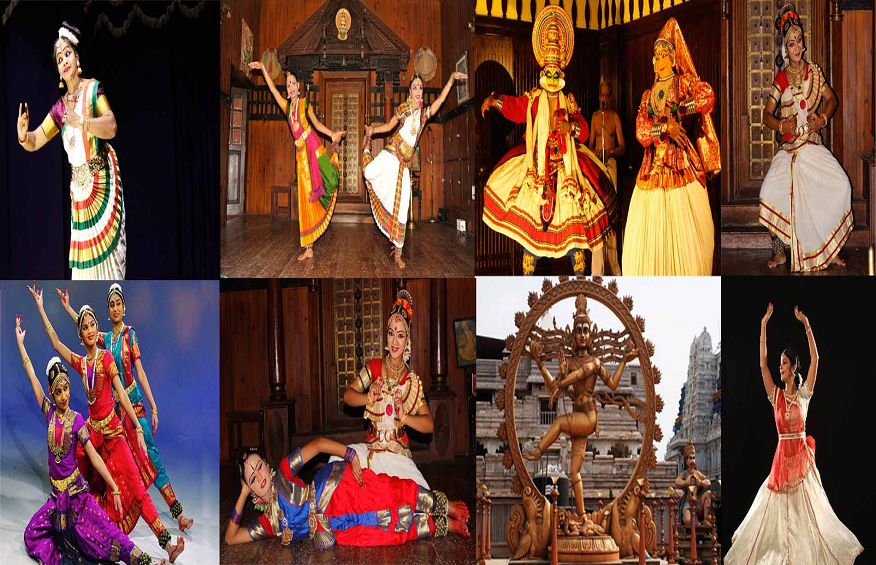When it comes to the rich cultural tapestry, classical dances of India forms are among the most vibrant and captivating expressions of tradition and artistry. Each region of India boasts its own unique classical dances of India styles, deeply rooted in history, mythology, and local customs.
In this comprehensive guide, we will embark on a journey to explore the classical dances of India forms of North, South, East, and West India, shedding light on their distinctive features, origins, and significance.
1. The Graceful Elegance of Bharatanatyam (South India)
Let’s kickstart our journey in the southern region of India, where Bharatanatyam holds a prominent position. This captivating dance form has its roots in the temples of Tamil Nadu and is known for its intricate footwork, expressive facial expressions, and elegant hand movements. Bharatanatyam is intricately linked with Hindu mythology and frequently showcases narratives from epics such as the Ramayana and Mahabharata.
The dazzling costumes and ornate jewelry worn by Bharatanatyam performers contribute to its visual allure, creating a spellbinding experience for onlookers.
For an enriching experience, delve into the fascinating realm and know more about classical dances of India their intricate beauty and cultural significance
2. The Rhythmic Brilliance of Kathak (North India)
Moving to North India, we encounter the rhythmic brilliance of Kathak. This classical dances of India form is known for its intricate footwork, rhythmic spins, and the melodious sound of ankle bells. Kathak evolved in the royal courts of North India, particularly during the Mughal era, blending elements of Persian and Indian culture.
One of its most distinctive features is the storytelling aspect, where dancers use expressive facial expressions and hand movements to narrate tales from Indian folklore and mythology.
3. The Expressive Prowess of Odissi (East India)
Traveling to the eastern part of India, we discover the expressive prowess of Odissi. Originating in the state of Odisha, this dance form is characterized by its fluid movements, sculptural poses, and intricate facial expressions. Odissi often depicts stories from the life of Lord Jagannath and celebrates the region’s rich cultural heritage. Dancers adorn themselves with traditional silver jewelry and vibrant silk costumes, adding to the visual allure of this classical art.
4. The Vibrant Energy of Kathakali (West India)
Our exploration culminates in the western part of India, where Kathakali stands as a prominent representative. Originating from the state of Kerala, this dynamic and theatrical dance form is celebrated for its intricate makeup, vibrant attire, and exaggerated facial expressions.
Kathakali performances are a feast for the eyes, frequently depicting narratives from the Ramayana and the Mahabharata. Dancers undergo intensive training, mastering intricate hand gestures and facial makeup techniques to vividly portray these epic stories on the stage.
5. The Traditional Significance of Manipuri Dance (Northeast India)
Venturing into the northeastern part of India, we encounter the traditional significance of Manipuri dance. Hailing from the state of Manipur, this dance form is deeply rooted in the region’s religious and cultural practices.
Manipuri dance is characterized by its graceful, fluid movements, and it often revolves around themes of love and devotion to Lord Krishna. The dancers wear elaborate traditional costumes, including colorful skirts and ornate headdresses, adding to the spiritual and aesthetic appeal of this classical art form.
6. The Fusion of Folk and Classical: Mohiniyattam (South India)
Returning to South India, we discover the unique fusion of folk and classical elements in Mohiniyattam. This dance form, originating in Kerala, is known for its lyrical and graceful movements that imitate the swaying of palm trees and the gentle waves of the ocean. Mohiniyattam derives its name from “Mohini,” the enchantress avatar of Lord Vishnu, and “attam,” meaning dance. It often portrays stories of love and devotion, making it a captivating blend of classical and folk traditions that showcase the beauty and serenity of South India’s cultural heritage.
Conclusion: A Tapestry of Cultural Diversity
In conclusion, India’s classical dances form a testament to the country’s rich cultural diversity and artistic heritage. Each region’s unique dance style reflects the traditions, history, and mythology of that area. From the grace of Bharatanatyam in the South to the rhythmic elegance of Kathak in the North, the expressive Odissi in the East, and the vibrant Kathakali in the West, these dance forms continue to captivate audiences worldwide.
To truly appreciate classical dances of India, one must witness the dedication and passion of the artists who bring these ancient art forms to life. Their performances not only entertain but also serve as a bridge to India’s rich past, allowing us to connect with the stories and emotions that have been passed down through generations.
So, the next time you have the opportunity to know more about classical dances of India performance, take a moment to appreciate the regional variations and the centuries-old traditions that continue to thrive in the diverse landscape of India. It’s a journey that
promises not just entertainment but a deeper understanding of India’s cultural heritage.

